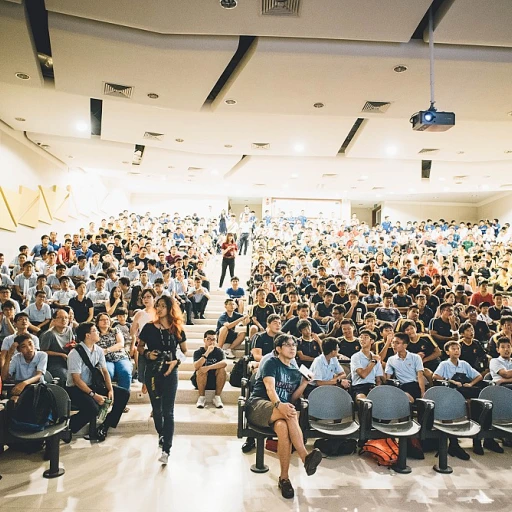Understanding the Skills Gap
Grasping the Essence of Skill Shortages
In today's rapidly evolving work culture, understanding the skills gap is pivotal. This disparity between the skills that employers require and those being taught or possessed by the workforce impacts various sectors. Students and professionals alike are feeling the pinch as workplaces increasingly demand capabilities that align with modern technological and managerial practices. The gap in diversity, equity, inclusion, and justice (DEIJ) in professional environments further complicates the scenario. Ensuring an inclusive work culture requires not only skills in technical areas but also competencies in handling DEIJ matters. Unconscious biases and a lack of inclusive practices can hinder growth and learning opportunities, making the need for DEIJ training even more pressing. To address the widening skills gap, professional development programs are being revamped to include diverse resources and provide comprehensive training. DEIJ initiatives are now integral to this transformation, aiming to imbue workplaces with leadership goals that prioritize equity and inclusion. For those seeking to bridge this gap, exploring the best skill-building programs is a crucial step. These programs incorporate inclusive teaching strategies and project management techniques to enhance not only technical abilities but also promote mental health and psychological safety in diverse learning environments. Therefore, understanding and effectively bridging the skills gap requires a dual focus: advancing technical skills while fostering an inclusive, equitable, and diverse workplace. As we delve into the role of DEIJ training in the subsequent discussion, it becomes clear that organizations willing to invest in such initiatives are better poised to thrive in today's competitive landscape.The Role of DEIJ Training
The Impact of DEIJ Training in Addressing Skill Deficiencies
Diversity, Equity, Inclusion, and Justice (DEIJ) training is crucial in resolving the skills gap that has become a significant barrier in the workplace. This training aims to cultivate a workplace culture that not only embraces diversity and inclusion but also ensures that equity and justice are at the forefront of organizational values.
DEIJ training goes beyond basic diversity training. It delves into unconscious bias, enabling employees and leaders to recognize and address these biases, which can impede equitable professional development. By promoting an inclusive environment where all voices are heard, such training programs foster innovation and enhance problem-solving skills within diverse teams.
Moreover, DEIJ initiatives offer a comprehensive understanding of social justice, equipping students and employees with the tools they need for leadership in diverse settings. This approach is echoed in impactful initiatives like those found in St. Louis's renewable energy sector, where bridging the skills gap effectively requires diverse perspectives and collaborative efforts.
Significantly, DEIJ training also emphasizes psychological safety, ensuring that individuals feel secure to share ideas without fear of judgment. This environment enhances learning and development, making it easier for organizations to nurture talent and bridge any existing skills gap.
Overall, DEIJ training stands as an integral component of a holistic approach towards closing skill deficiencies. By embedding equity and inclusion into the core of workplace culture, organizations not only meet the demands of a diverse workforce but also pave the way for more inclusive teaching and learning opportunities.
Key Components of Effective DEIJ Training
Core Elements of Successful DEIJ Training Programs
In addressing the skills gap, the training landscape must focus on crafting Diversity, Equity, Inclusion, and Justice (DEIJ) initiatives that foster a more inclusive culture both in workplaces and educational settings. Below are some essential components that make DEIJ training effective:- Interactive and Engaging Content: Successful DEIJ programs actively involve participants through interactive processes rather than passive lectures. This approach facilitates deeper learning and encourages students and professionals to internalize diversity and inclusion principles. By employing inclusive teaching methods, trainers aim to mitigate unconscious bias and promote inclusive justice within organizations.
- Customization to Specific Needs: Programs should be adaptable to the unique challenges and culture of each organization. Tailoring DEIJ training ensures that resources are relevant and applicable, leading to practical outcomes in both school and work environments.
- Integration of Social Justice and Equity Principles: A robust DEIJ training course will examine underlying issues of social justice and equity, allowing participants to understand how these factors interact with their professional and personal lives. Equipping leadership teams with this knowledge fosters a more inclusive and equitable workplace.
- Continuous Learning and Professional Development: Effective DEIJ programs encourage ongoing learning rather than being a one-time event. This approach nurtures a culture of continuous improvement and adaptation, essential for bridging the skills gap through diversity and inclusion.
- Emphasis on Psychological Safety: Creating a safe space for open dialogue is crucial. Employees and students should feel empowered to discuss challenging topics without fear of judgment or repercussions. This aspect of DEIJ training helps build trust and fosters a supportive community.
Challenges in Implementing DEIJ Training
Overcoming Barriers in DEIJ Training Implementation
Implementing Diversity, Equity, Inclusion, and Justice (DEIJ) training in the workplace or educational settings is crucial for addressing the skills gap. However, several challenges can hinder its effectiveness. Recognizing these barriers is the first step toward creating a more inclusive and equitable environment.
Resource Allocation and Commitment
One of the primary obstacles is the allocation of resources. Organizations often struggle with dedicating sufficient time and budget to DEIJ initiatives. Without a strong commitment from leadership, these programs may lack the necessary support to thrive. It's essential for leaders to view DEIJ training as an investment in their workforce's professional development and the organization's culture.
Resistance to Change
Another significant challenge is resistance to change. Employees and students may be hesitant to engage in training that addresses unconscious bias and promotes social justice. This resistance can stem from a lack of understanding or fear of the unknown. To overcome this, DEIJ programs must be designed to foster psychological safety, encouraging open dialogue and inclusive teaching methods.
Measuring Impact and Success
Measuring the impact of DEIJ training can be difficult. Organizations need to establish clear metrics to assess the effectiveness of their programs. This involves evaluating changes in workplace culture, employee engagement, and the overall inclusivity of the environment. By doing so, organizations can ensure that their DEIJ initiatives are not only symbolic gestures but also catalysts for meaningful change.
Ensuring Continuous Learning
Finally, DEIJ training should not be a one-time event. Continuous learning is crucial for sustaining progress in diversity, equity, and inclusion efforts. Programs should be regularly updated to reflect current social issues and include diverse perspectives. Encouraging ongoing learning helps maintain momentum and keeps the conversation about equity and inclusion alive in the workplace and schools.
Success Stories: DEIJ Training in Action
Inspiring Transformations Through DEIJ Training
The journey to bridge the skills gap through Diversity, Equity, Inclusion, and Justice (DEIJ) training has proven successful across various sectors. These real-world applications demonstrate not only the importance of such initiatives but also the transformative effects they can have on individuals and organizations. One of the most impactful success stories comes from an educational institution that integrated DEIJ training into its curriculum. By creating a course that wove concepts of diversity, inclusion, and justice into everyday learning, students reported an increased understanding of global cultures and a heightened sense of social responsibility. This inclusive teaching model not only enriched students' academic experiences but also prepared them for more diverse workplaces in the future. In corporate environments, organizations that have committed to DEIJ training often see a notable shift in workplace dynamics. A leading company implemented an inclusion training program focusing on unconscious bias and equity inclusion. Employees reported improved psychological safety and a more inclusive company culture. The leadership team's dedication to professional development and continuous learning played a pivotal role in nurturing this inclusive environment. Public sector institutions have also embraced these initiatives, often as part of broader justice efforts. One governmental department introduced a DEIJ course that examined systemic barriers and promoted equity-driven project management. The positive feedback highlighted an increased awareness of mental health and social justice issues among participants, translating to more effective service delivery. These instances underscore the critical role that DEIJ training can play in not just filling skills gaps but also in cultivating a more just and equitable society. By investing in comprehensive programs that address diversity, inclusion, and equity, organizations can foster a workplace culture that values every individual, paving the way for sustained success and innovation.Future Trends in DEIJ Training
Emerging Trends in DEIJ Training
The landscape of diversity, equity, inclusion, and justice (DEIJ) training is evolving rapidly, influenced by changes in the workplace and educational environments. As organizations and institutions strive to bridge the skills gap, staying ahead of these trends is crucial.
Technology Integration
One significant trend is the integration of technology into DEIJ training programs. Virtual reality (VR) and augmented reality (AR) are being used to create immersive learning experiences that enhance understanding of unconscious bias and cultural diversity. These technologies allow students and professionals to engage with scenarios that promote empathy and inclusive thinking.
Focus on Psychological Safety
Another emerging focus is on psychological safety within the workplace. Training programs are increasingly addressing the need for environments where employees feel safe to express themselves without fear of negative consequences. This approach not only supports mental health but also fosters a culture of innovation and collaboration.
Customization and Personalization
DEIJ training is moving towards more personalized learning experiences. Tailoring programs to meet the specific needs of diverse teams or individuals enhances engagement and effectiveness. This trend emphasizes the importance of understanding the unique dynamics of each workplace or educational setting.
Leadership and Accountability
Leadership development is becoming a core component of DEIJ initiatives. Training programs are focusing on equipping leaders with the skills necessary to champion diversity and inclusion efforts. This includes fostering an equitable culture and holding themselves accountable for progress.
Collaborative Learning Environments
Finally, there is a growing emphasis on creating collaborative learning environments. By encouraging dialogue and shared learning experiences, DEIJ training programs can build a more inclusive culture. This approach not only supports professional development but also strengthens the community within the organization.












